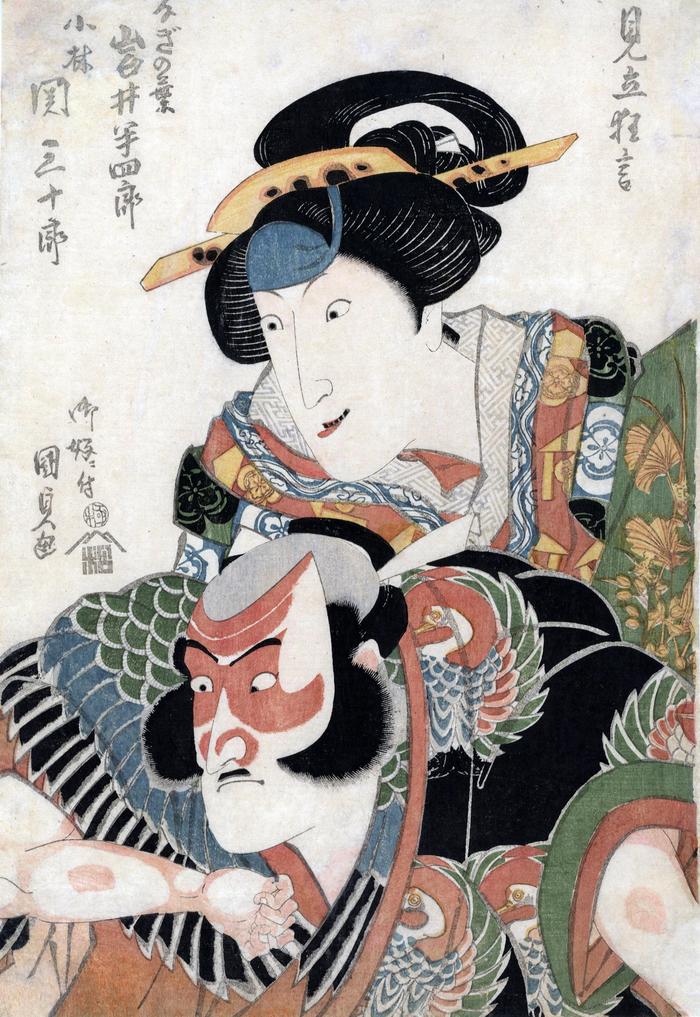Utagawa Kunisada (歌川国貞) / Toyokuni III (三代豊国) (artist 1786 – 01/12/1865)
Iwai Hanshirō V (岩井半四郎) as Naginoha (なぎの葉) and Seki Sanjūrō II (関三十郎) as the giant Kobayashi Asahina (小林朝比奈) from the series 'Mitate Kyogen' (見立狂言 - Imaginary Plays)
1820
10 in x 14.5 in (Overall dimensions) woodblock print
Signed: okonomi ni tsuki (out of my own taste) Kunisada ga
御好ニ付国貞画
Publisher: Matsumura Tatsuemon
(Marks 311 -seal 03-009)
Censor's seal: kiwame
The National Museum of Asian Art
British Museum - 1813 Toyokuni I print of Naginoha
Bibliotheque Nationale - ca. 1771 Shunshō ehon illustration with Naginoha on the left
Berkeley Art Museum and Pacific Film Archive at the University of California The signature okonomi ni tsuki (out of my own taste) Kunisada ga (御好ニ付国貞画) was only used in the 1820s according to Jan van Doesburg.
****
Naginoha Gozen in some accounts is the younger sister of Suketsune and is therefore related to the Soga brothers' revenge plays. Other sources generally list her as Suketsune's wife, as is shown here in this imaginary pairing of her with the strongman Asahina. Naginoha's name is sometimes printed as '梛葉'. Subtly display on her robes is an identifying Soga crest: the iori mokko (庵に木瓜) or crest of a four-petaled 'magnolia' flower sheltered under the roof of a hut. In the image by Toyokuni I which we have added to this page the crest is more prominent showing Naginoha wearing her husband's robe.
****
There were a number of 18th century kabuki plays centered around Naginoha: Naginoha Asahi Genji and Naginoha Izu no Sugatami.
****
The actor playing Ashaina is wearing sideburns which were referred to as kamahige (鎌髭) or a scythe beard. In a September, 1995 issue of Andon Robert Schaap made a reference to the white paper protrusions coming off the back of Asahina's head. They are chikara-gami (力紙) symbolizing strength and masculinity. It should be noted that chikara-gami is also used but in a different way in sumo ceremonies. Chikara can mean strength, energy or power combined with gami which means paper.
Schaap also wrote about the origin of Asahina's crane in a circle motif: "Moreover for the stage character Asahina the actor Nakamura Denkurō I (1662-1713) preferred his own tsuru-no-maru (tsuru, crane; maru, circle, round) crest: an impressionistic crane with wings outstretched above its head, forming a circular figure."
****
Illustrated: There is a small black and white reproduction of this image on page 334 of Masterful Illustrations: Japanese Prints in the Anne van Biema Collection.
actor prints (yakusha-e - 役者絵) (genre)
Seki Sanjūrō II (二代目関三十郎: 11/1807-2/1839) (actor)
Matsumura Tatsuemon (松村辰右衛門) (publisher)
mitate-e (見立て絵) (genre)
Asahina Saburō (朝比奈三郎) (role)
Iwai Hanshirō V (五代目岩井半四郎: 11/1804-11/1832) (actor)
Soga brothers (曾我兄弟) (genre)
